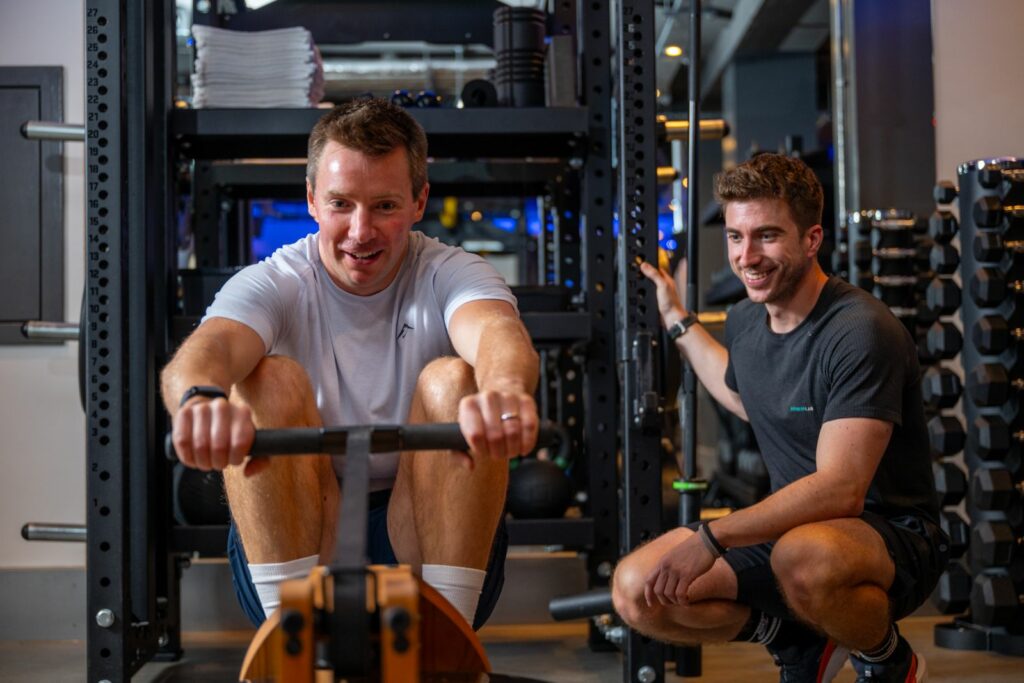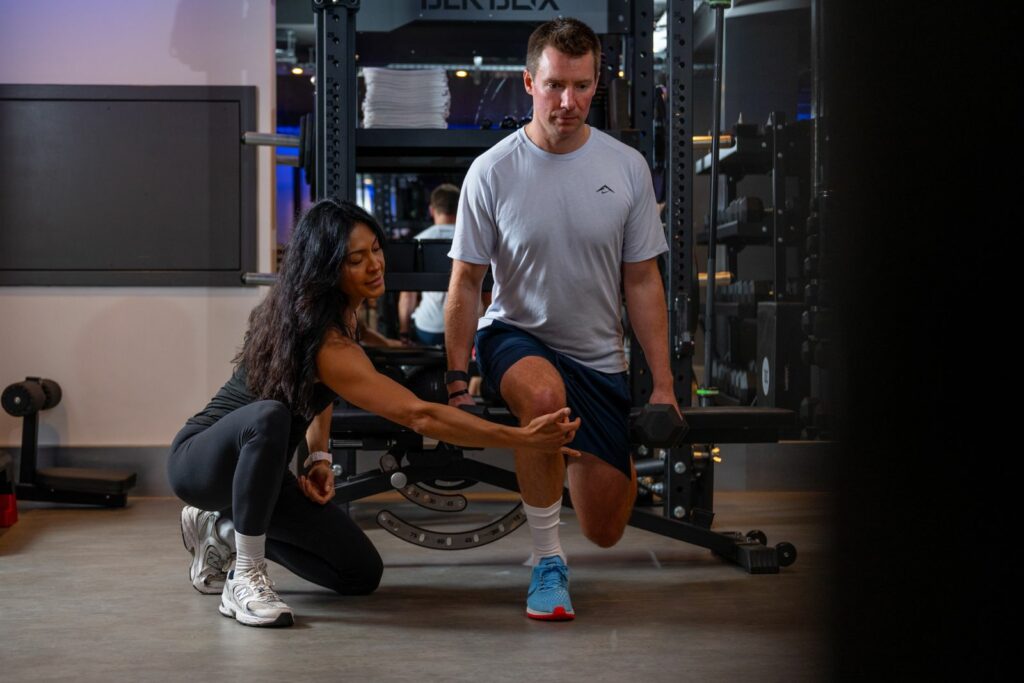Do a quick Google search about whether cardio or strength training is the right approach for fat loss and you’ll likely end up scratching your head. Some sources claim cardio’s the best bet, whereas others will explain why lifting weights is the way forward.
In reality, there’s no right or wrong – just what works for you. If you’re like most people – short on time and looking for the most effective way to change your body composition – strength training should be your go-to.
Here, we’ll break things down a little more, explaining how both approaches impact fat loss in different ways – and, most importantly, how to decide which will work best for you.
At a Glance
Strength training beats cardio for fat loss because it helps you build muscle mass, which boosts your resting metabolism. While cardio burns more calories during a session, weight training keeps burning calories for hours (or even days) afterwards.
If you’re short on time and want lasting results, resistance training gives you the best return on effort and time in your gym gear.
Why is There Confusion Around Which Burns More Calories?
Wondering why there’s confusion around the best approach for fat loss? Well, at first glance, cardiovascular exercise seems like the obvious winner. Go for a run, do a spin class, hit a HIIT session and you’ll see your calorie tracker light up. Aerobic exercise does burn a lot of calories during the session itself – so it’s easy to think: more sweat, more burn, better results. Right?
The thing is, it’s not quite that simple.
While cardio workouts are great for cardiovascular health and do torch calories in the moment, that immediate burn doesn’t tell the whole story. It’s useful to think of cardio like a one-time payment – you burn calories now, and then… well, that’s the full story. Strength training, on the other hand, can be thought of more like a sure-thing investment – it keeps paying dividends long after you’ve left the gym.
| Training Type | Calories Burned During Workout | Afterburn Effect (EPOC) | Long-Term Metabolic Impact |
| Cardio Workout | High | Low to Moderate | Minimal change to resting metabolism |
| Strength Training | Moderate | High | Increased resting metabolic rate via increased muscle mass |
What Exactly is EPOC – and Why Should You Care?
EPOC stands for Excess Post-exercise Oxygen Consumption – the scientific term for the extra calories your body burns after you train, as it works to recover.

After a strength training session, your body has to repair muscle fibres, restore oxygen, and balance out hormones. This recovery process takes time and energy – which means you’re still burning calories long after you’ve left the gym.
This is no 15-minute wonder either. EPOC following resistance training can last up to between 24–48 hours, depending on the intensity of your session. So while cardio gives you an immediate calorie hit, strength training gives you passive calorie burn that keeps working long after you’ve finished your session.
What Kind of Metabolic Advantage Does Muscle Mass Offer?
Now that we’ve covered EPOC, let’s talk about what fuels it – muscle.
The more muscle mass you carry, the higher your resting metabolic rate. That means you’ll burn more calories simply by going about your everyday life – whether that’s sitting at your desk, watching TV, reading a book, or even sleeping. Unlike fat, muscle is metabolically active tissue, and it works in your favour around the clock.
This is where weight training comes into its own. It’s not just about what happens during the workout, but what you’re building for the long-term. More muscle = more calorie burn = greater fat loss.
If you’re short on time and can only commit to a 1-3 sessions a week, building muscle through resistance training is your best bet for a leaner, more efficient body.
But Doesn’t Cardio Improve Fitness?
Cardio absolutely does improve fitness – and it deserves credit for that. Cardiovascular exercise offers a series of health benefits, including improving heart and lung capacity, boosting mood, and supporting general well-being. If you enjoy running, cycling, or moving the coffee table and dancing around your living room to a cardio DVD, then by all means keep doing it. Cardio and strength training are not enemies. They can (and should) complement each other.

The issue isn’t that cardio is bad – it’s that it’s often oversold as the most effective tool for fat loss, especially for those who are already stretched for time. The calorie burn during a cardio session might look great, but it doesn’t change your metabolic engine the way strength training does.
Beyond Fat Loss, What Are Some Additional Health Benefits of Strength Training?
So, training to increase muscle and strength seems to be winning in terms of time-spent and the on-going effect on your levels of body fat – but what if we told you those benefits are just the tip of the iceberg?
Increasing the amount of lean muscle you carry comes with a list of health and longevity benefits that, if bottled, would be an instant best-seller. Those benefits include:
- Increased lean muscle mass: More lean muscle means a better metabolic rate and a toned, defined look.
- Improved bone health: Resistance training is one of the best ways to protect against age-related bone loss.
- Better insulin sensitivity: Strength exercises can improve blood sugar control, supporting long-term health.
- Injury prevention: Building strength helps support joints, improve posture, and reduce risk of injury.
- Body confidence: It’s important not to underplay this – feeling strong and capable in your body can transform your mindset.
These benefits are incredible additions at any time of life – but, they become even more important beyond your mid-30s. Like it or not, this is when hormone balances in the body change – and muscle mass will naturally decline. Maintaining strength and muscle into and beyond mid-life is proven to reduce all-cause mortality risk by significant numbers, which is another big tick in the strength training box.
Why is Resistance Training The Better Option for the Time-Poor?
Are you someone who considers time on their side – with countless hours of downtime every day? No? Hardly surprising – Central London life rarely happens at a snail’s pace.

If, like most people, you can only justify spending 1-3 hours a week on improving your fitness, it’s tough to beat the efficiency of strength training. With a well-structured programme of resistance training – using free weights, machines, or to a slightly lesser extent, body weight – you’re not just burning calories in the moment. You’re increasing muscle mass, improving body composition, and turning your body into a more efficient calorie-burning machine.
That’s what we mean when we say strength training “accrues interest”. It works while you rest. You’re not just getting leaner during the workout – you’re setting yourself up to burn more calories all day long.
Cardio and strength workouts together can be powerful – but if time dictates that you have to choose one, and your primary goal is fat loss, strength training is the smarter bet.
Won’t Combining Cardio and Strength Accelerate Fat Loss?
As we’ve mentioned, we’re not saying cardio has no place in fitness. Combining cardio and strength training can lead to fantastic results, especially for overall health, endurance, and longevity. But, it comes with a caveat – it has to be programmed well. Too much cardio could interfere with recovery from strength sessions, and vice versa.
If you love a cardio exercise like cycling, swimming or running – you definitely don’t have to give it up. Just don’t rely on it alone for fat loss. Use it to complement your weight training, not replace it. A couple of shorter cardio sessions each week, alongside 2-3 strength-focused workouts, can be a solid formula.
An Added Strength Training Bonus
Before we wrap up, there’s another bonus associated with strength training that has nothing to do with health – it’s the intensity of the sessions.
If you’ve been to a spin class, group ‘boot camp’ cardio session, or anything similar, you’ll know that you pulling your work clothes on and walking into a meeting 10 minutes later isn’t practical. Strength training doesn’t have you leaving the studio dripping with sweat or needing a two-hour rehydration protocol.

Sure, you’ll feel the workout in your muscles, and we’re not saying you won’t break a sweat – but working towards lower body fat by improving strength and muscle is far easier to fit into your routine than a cardio session that requires immediate recovery.
Final Thoughts: Training For Strength is the Smart Fat Loss Choice
When it comes to strength training vs cardio, the real question isn’t which one burns more calories during the workout. It’s more about which one delivers more value over time.
If your goal is to lose body fat, improve muscle tone, and make your metabolism work harder while you rest, strength training wins hands down. Not because cardio is useless – far from it – but because building muscle changes your body in a fundamentally more sustainable way.
If resistance training sounds like it could work for you – don’t panic about walking into a public gym and hoping to find YouTube videos to guide your session. This is exactly where we come in. At Fitness Lab, we tailor strength training programmes to your lifestyle, fitness level, and goals. Whether you’re new to strength training or coming back after any length of break, our world-class trainers will help you get stronger, leaner, and healthier – for the long term.

